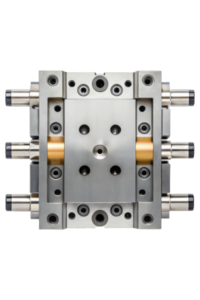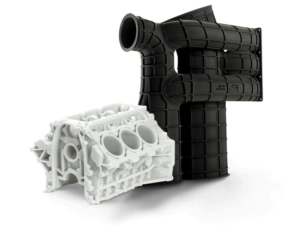Developing & producing injection-molded products follows a proven process
The journey of creating and manufacturing injection-molded products follows a well-established and refined process that has evolved over several decades. This process is integral to launching products that involve components produced through injection molding. The process consists of distinct phases, as depicted in the accompanying diagram, each of which contributes crucial information for delivering a high-quality product to the market in commercially viable quantities and at a reasonable cost. Prototype tooling plays a pivotal role in this intricate process.
The investment of time, effort, and resources in each phase is notably influenced by the specific design and functional parameters of the target product. For the purposes of our discussion, a simplified rule of thumb can be applied: the effort and cost required to make changes to a product increase by approximately tenfold with each subsequent step. While this rule oversimplifies the scenario for complex products, it underscores key insights for product designers, project managers, and business executives:
- Early Information Mitigates Risk: Acquiring more comprehensive information at the outset of a project reduces potential risks.
- Early Problem Identification: Detecting design and manufacturability issues at an early stage significantly minimizes overall project costs.
- Cost-Efficiency of Early Changes: Modifications made earlier in the process are considerably less expensive.
Challenging the Notion of Skipping Steps
It might seem logical to presume that bypassing certain steps in the process would expedite the time and reduce the cost of bringing a product to market. While this assumption holds true in some instances, such as minor alterations to familiar products like bottle caps, it’s important to recognize that for intricate designs – such as ergonomic consumer products with unique features – relying solely on past experience, simulations, and rapid prototyping may not yield accurate predictions regarding appearance, critical dimensions, or functionality when molded with the intended production material.
The Complexity of Rectifying Production Tooling Issues
Once the design for a high-efficiency steel injection mold has been finalized and mold production initiated, the costs associated with making alterations escalate due to the time and labor required for even minor adjustments to the tool. Tasks like additional CNC machining, EDM (Electrical Discharge Machining), benchwork, and texturing accumulate rapidly. The nature of hardened tool steel, especially when polished or textured, makes modifications intricate. This challenge is compounded by the need to remove the tool from the press, whether it’s sent back to the in-house mold department or transported to an external mold manufacturer for adjustments. These processes can lead to significant delays, particularly if international operations are involved.
The Value of Investing in Prototype Tooling
Prototype tooling, as defined by Quickparts, encompasses the production of high-quality injection molds utilizing state-of-the-art CNC equipment and masterful craftsmanship. These molds are fashioned from a premium-grade aluminum specially tailored for injection molding applications. The advantages of Quickparts’ prototype injection molds manifest in the following ways:
- Cost-Efficient Corrections: Rectifications to injection molded components during validation and pre-production phases are notably more affordable.
- Design and Material Exploration: The cost of experimenting with design and material options is significantly reduced.
As previously mentioned, the expenses linked to altering production tooling far exceed those incurred in modifying prototype tooling. Moreover, when uncertainties persist about component design and material choices, engaging in such experimentation within hardened steel molds is usually cost-prohibitive.
The Significance of Early Validation and Correction
Quickparts is capable of delivering injection-molded projects within remarkably short timeframes – typically under 13 business days, and sometimes even under five business days upon request for specific products. Despite the sequential nature of these activities, the time invested is well justified due to its early placement in the project timeline. Identifying and addressing issues weeks or months ahead of what would be possible with production tooling averts potential pitfalls. While recognizing that there isn’t a direct equivalence between the performance of prototype tooling and production tooling, insights regarding dimensional accuracy, material behavior, shrinkage, warping, sink marks, splay, and aesthetics can all be garnered using Xcentric prototype molds, molded with the intended production material.
Comparing Standard Process and Skipping Prototype Molding
The accompanying diagram contrasts the conventional process with an alternate process that involves skipping prototype molding to expedite time. Notable takeaways include the fact that the time required to both recognize and address problems is advanced by several weeks. Depending on the severity of required modifications, the overall project duration might even be shorter when accounting for prototype tooling adjustments.
Mitigating Product Launch Risks
Identifying and rectifying production challenges early in the process serves to de-risk the project by allowing ample time for responsive measures. Executive management and downstream customers are typically unforgiving when confronted with last-minute delays attributed to production tooling, potentially resulting in significant postponements of the product launch. The detrimental impact of substantial launch delays on the net present value of the product is widely acknowledged across industries. Explaining such delays with the absence of a prototype tooling budget underscores the value of prototype tooling as an insurance policy to curtail risks associated with new product introductions.
Key Insights into Time and Cost Savings through Prototype Tooling
Incorporating the step of validating designs, identifying improvements, and preempting downstream issues through prototype injection molding has consistently demonstrated its efficacy in saving both time and money across numerous projects. Early learning and rectification yield dividends in terms of risk mitigation. Ultimately, the overarching goal is to deliver the best possible product to the market with expediency, aligning seamlessly with Quickparts’ mission.


